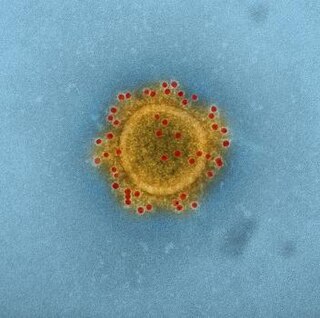
Coronaviridae is a family of enveloped, positive-strand RNA viruses which infect amphibians, birds, and mammals. The group includes the subfamilies Letovirinae and Orthocoronavirinae; the members of the latter are known as coronaviruses.
Bovine coronavirus is a coronavirus which is a member of the species Betacoronavirus 1. The infecting virus is an enveloped, positive-sense, single-stranded RNA virus which enters its host cell by binding to the N-acetyl-9-O-acetylneuraminic acid recepter. Infection causes calf enteritis and contributes to the enzootic pneumonia complex in calves. It can also cause winter dysentery in adult cattle. It can infect both domestic and wild ruminants and has a worldwide distribution. Transmission is horizontal, via oro-fecal or respiratory routes. Like other coronaviruses from genus Betacoronavirus, subgenus Embecovirus, it has a surface protein called hemagglutinin esterase (HE) in addition to the four structural proteins shared by all coronaviruses.

Middle East respiratory syndrome–related coronavirus (MERS-CoV), or EMC/2012 (HCoV-EMC/2012), is the virus that causes Middle East respiratory syndrome (MERS). It is a species of coronavirus which infects humans, bats, and camels. The infecting virus is an enveloped, positive-sense, single-stranded RNA virus which enters its host cell by binding to the DPP4 receptor. The species is a member of the genus Betacoronavirus and subgenus Merbecovirus.

Human coronavirus HKU1 (HCoV-HKU1) is a species of coronavirus in humans and animals. It causes an upper respiratory disease with symptoms of the common cold, but can advance to pneumonia and bronchiolitis. It was first discovered in January 2004 from one man in Hong Kong. Subsequent research revealed it has global distribution and earlier genesis.

Betacoronavirus is one of four genera of coronaviruses. Member viruses are enveloped, positive-strand RNA viruses that infect mammals, including humans. The natural reservoir for betacoronaviruses are bats and rodents. Rodents are the reservoir for the subgenus Embecovirus, while bats are the reservoir for the other subgenera.

Human coronavirus OC43 (HCoV-OC43) is a member of the species Betacoronavirus 1, which infects humans and cattle. The infecting coronavirus is an enveloped, positive-sense, single-stranded RNA virus that enters its host cell by binding to the N-acetyl-9-O-acetylneuraminic acid receptor. OC43 is one of seven coronaviruses known to infect humans. It is one of the viruses responsible for the common cold and may have been responsible for the 1889–1890 pandemic. It has, like other coronaviruses from genus Betacoronavirus, subgenus Embecovirus, an additional shorter spike protein called hemagglutinin-esterase (HE).

Alphacoronaviruses (Alpha-CoV) are members of the first of the four genera of coronaviruses. They are positive-sense, single-stranded RNA viruses that infect mammals, including humans. They have spherical virions with club-shaped surface projections formed by trimers of the spike protein, and a viral envelope.

Betacoronavirus 1 is a species of coronavirus which infects humans and cattle. The infecting virus is an enveloped, positive-sense, single-stranded RNA virus and is a member of the genus Betacoronavirus and subgenus Embecovirus. Like other embecoviruses, it has an additional shorter spike-like surface protein called hemagglutinin esterase (HE) as well as the larger coronavirus spike protein.

Human coronavirus 229E (HCoV-229E) is a species of coronavirus which infects humans and bats. It is an enveloped, positive-sense, single-stranded RNA virus which enters its host cell by binding to the APN receptor. Along with Human coronavirus OC43, it is one of the viruses responsible for the common cold. HCoV-229E is a member of the genus Alphacoronavirus and subgenus Duvinacovirus.
Tylonycteris bat coronavirus HKU4 is an enveloped, positive-sense single-stranded RNA virus mammalian Group 2 Betacoronavirus that has been found to be genetically related to the Middle East respiratory syndrome-related coronavirus (MERS-CoV) that is responsible for the 2012 Middle East respiratory syndrome coronavirus outbreak in Saudi Arabia, Jordan, United Arab Emirates, the United Kingdom, France, and Italy.
Rhinolophus bat coronavirus HKU2 is a novel enveloped, single-stranded positive-sense RNA virus species in the Alphacoronavirus, or Group 1, genus with a corona-like morphology.
Scotophilus bat coronavirus 512 is an enveloped, single-stranded positive-sense RNA virus species in the Alphacoronavirus, or Group 1, genus with a corona-like morphology. It was isolated from a lesser Asiatic yellow house bat discovered in southern China.
Bulbul coronavirus HKU11 is a positive-sense single-stranded RNA Deltacoronavirus of avian origin found in Chinese bulbuls.

MERS coronavirus EMC/2012 is a strain of coronavirus isolated from the sputum of the first person to become infected with what was later named Middle East respiratory syndrome–related coronavirus (MERS-CoV), a virus that causes Middle East respiratory syndrome (MERS).

Embecovirus is a subgenus of coronaviruses in the genus Betacoronavirus. The viruses in this subgenus, unlike other coronaviruses, have a hemagglutinin esterase (HE) gene. The viruses in the subgenus were previously known as group 2a coronaviruses.

Merbecovirus is a subgenus of viruses in the genus Betacoronavirus, including the human pathogen Middle East respiratory syndrome–related coronavirus (MERS-CoV). The viruses in this subgenus were previously known as group 2c coronaviruses.
Nobecovirus is a subgenus of viruses in the genus Betacoronavirus. The viruses in the group were previously known as group 2d coronaviruses.

Coronavirus diseases are caused by viruses in the coronavirus subfamily, a group of related RNA viruses that cause diseases in mammals and birds. In humans and birds, the group of viruses cause respiratory tract infections that can range from mild to lethal. Mild illnesses in humans include some cases of the common cold, while more lethal varieties can cause SARS, MERS and COVID-19. As of 2021, 45 species are registered as coronaviruses, whilst 11 diseases have been identified, as listed below.

The history of coronaviruses is an account of the discovery of the diseases caused by coronaviruses and the diseases they cause. It starts with the first report of a new type of upper-respiratory tract disease among chickens in North Dakota, U.S., in 1931. The causative agent was identified as a virus in 1933. By 1936, the disease and the virus were recognised as unique from other viral disease. They became known as infectious bronchitis virus (IBV), but later officially renamed as Avian coronavirus.









